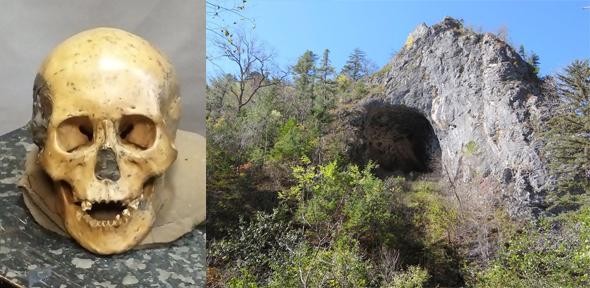By Ana Verayo, | February 02, 2017

Exterior of Devil’s Gate. Left: One of the skulls found in the Devil’s Gate cave. (Elizaveta Veselovskaya/Yuriy Chernyavskiy/University of Cambridge)
DNA analysis of ancient human remains found in Russia suggests that modern East Asian people possess almost the same genetic makeup as their Stone Age hunter-gatherer ancestors.
Scientists found 7,700-year-old skeletal remains inside a cave known as "Devil's Gate" in the Primorye province of Russia, in the eastern coast. Two of the skeleton fossils still possessed well-preserved DNA evidence. This DNA evidence was particularly taken from a woman in her twenties and another woman in her fifties.
Like Us on Facebook
A team from Trinity College Dublin extracted the DNA from these ancient remains and compared it with modern day DNA specimens from the same region in Russia, obtained from an online database. This remarkable DNA evidence was so pristine that researchers were only able to spot a low contamination percentage of one to two percent.
Upon further analysis, the two genomes revealed that these are very similar to present day DNA of the Ulchi people dwelling in the Amur Basin in eastern Russia and the border of China, speaking the Tungusic language. Also, these Stone Age fossils were also found to be very similar to the ethnic groups in China that also speak this native language in this region.
Scientists say that the DNA evidence of the middle-aged woman was the most well preserved, and reveals clues about her appearance. This ancient woman most probably had brown eyes and thick, straight hair where she was most likely lactose intolerant but also did not possess an "alcohol flush" which is a common reaction of those with East Asian ethnicity.
These new findings also suggest that these people did not migrate too far out beyond the region in the span of 8,000 years. In contrast, western Europe's Neolithic communities experienced waves of farmers, horse riders, and craftsmen from other regions.
According to the author of the study, Veronika Siska from the University of Cambridge, the difference of the Stone Age Primorye region is that this area suffered from particularly harsh climate. Siska explains that it has been very difficult to reach this region, and the Ulchi preserved their traditional lifestyle, hunting, and fishing, until recent historical times, just within the last hundred years.
This new study was published in the journal Science Advances.
-
Use of Coronavirus Pandemic Drones Raises Privacy Concerns: Drones Spread Fear, Local Officials Say

-
Coronavirus Hampers The Delivery Of Lockheed Martin F-35 Stealth Fighters For 2020

-
Instagram Speeds Up Plans to Add Account Memorialization Feature Due to COVID-19 Deaths

-
NASA: Perseverance Plans to Bring 'Mars Rock' to Earth in 2031

-
600 Dead And 3,000 In The Hospital as Iranians Believed Drinking High-Concentrations of Alcohol Can Cure The Coronavirus

-
600 Dead And 3,000 In The Hospital as Iranians Believed Drinking High-Concentrations of Alcohol Can Cure The Coronavirus

-
COVID-19: Doctors, Nurses Use Virtual Reality to Learn New Skills in Treating Coronavirus Patients







